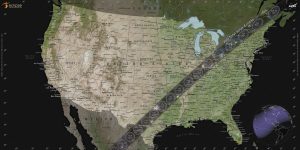 by Dr. Anne Mulhearn
by Dr. Anne Mulhearn
Most days you probably don’t feel a lot like staring at the sun, because it is very bright and it makes you squint. But on April 8th, Lowell will be in the shadow of the moon, sort of, and you may want to look up at the moon and the sun behind it, to see what that looks like. Best not to do that, though, as you can end up damaging your eyes.
Of course, as many of you know, Lowell will not be in the path of totality of this solar eclipse, which will start in the Pacific Ocean, first reach the Americas in Mexico in the morning and then travel east and north through the continental United States until entering the Atlantic off Newfoundland in the later afternoon. At the middle of the eclipse in Lowell, which will occur around 3:30 in the afternoon, the sun will be covered only about 93%.
 So, is there anything you can do during the eclipse which does not involve staring with your unprotected eyes at the sun? Yes. Here are a few suggestions.
So, is there anything you can do during the eclipse which does not involve staring with your unprotected eyes at the sun? Yes. Here are a few suggestions.
• If you haven’t already picked up a pair of eclipse viewing glasses from your local library you are almost certainly too late, since all the local libraries seem to have run out.
• You can attend a local eclipse watching party. Many local associations, including libraries, are holding parties. If you’re lucky, someone will bring a telescope with a special sun filter set up for sun viewing, and then you can get a really good look at the sun. A few libraries are advertising safe viewing options at their parties.
• You can make a sun viewing box. There are many suggestions on how to do this online. They all work by allowing you to look at a reflection of the sun, rather than directly at the sun.
So, why is this solar eclipse happening?
Well, for about ten hours on April 8th, the moon will be directly between some location on the earth and the sun and will cast a shadow. That location will be changing rapidly, though, and it won’t be right in between at any one place for very long. Even where there is a total eclipse, the totality won’t last very long, and the shadow will move on fairly rapidly.
 Why can the moon block the sun’s light like that?
Why can the moon block the sun’s light like that?
The moon is small and the sun is big, but the moon is close and the sun is far, so the moon’s apparent size is roughly the same as the sun’s. Suppose you have a dime in your hand and there’s a soccer ball on the other side of the field. Well, if you hold the dime out at the length of your arm and you look through just one eye, you can get the dime to completely cover the soccer ball. The principle is just the same.
How did the moon end up in front of the sun like that?
Well, if you look up tonight or tomorrow night you’ll notice that the night is moonless; the moon doesn’t rise until around 5 am, only an hour or so before the sun. When it does rise, it’s a narrow crescent moon, i.e. the bright part of the moon is shaped roughly like the letter C and most of the moon is dark. You can see the dark part of the moon if you look with care. That part of the moon is only shining because it reflects the sunlight reflected from the earth which is much less bright than light directly from the sun. Each day between now and April 8th, the moon will rise just a little bit later, and the part of the moon illuminated by the sun will be just a little narrower. On the 8th the moon will be a new moon, with no visible part of it illuminated by the sun at all; it will be just a dark circle in the daytime sky. The moon will rise around 6 AM, just like the sun and cross the sky at about the same speed as the sun in the same direction. You can only have a solar eclipse when the moon is new.
 Why isn’t there an eclipse every new moon?
Why isn’t there an eclipse every new moon?
Well, you only get an eclipse when the moon and the sun are following much the same path through the sky. When there is a new moon, the moon and the sun rise and set at around the same time, and follow similar paths, but usually those path are separate when viewed from the earth. The moon still casts a shadow, but that shadow never touches the earth anywhere, it passes above or below it. For a solar eclipse to happen, the moon’s path must cross the sun’s during the day, like a runner cutting into an adjacent lane. The moon rises a little to one side of the sun and sets on the other side from the view of the earth. Solar eclipses anywhere on the earth are fairly rare because the new moon and the cross-over must happen on the same day.
Does it strike you as a bit odd that the sun travels from east to west in the sky but the eclipse’s shadow will travel from west to east?
Well, that happens because all the apparent motion of the sun comes from the rotation of the earth, but some of the apparent motion of the moon comes from the moon’s movement around the earth. The moon is moving around the earth in the same direction that the earth is spinning, although a great deal more slowly, and so, relative to the sun, it is moving east.
 Do eclipses always travel south to north?
Do eclipses always travel south to north?
No, they alternate, and the next solar eclipse visible on earth will travel south, starting in the Pacific Ocean near the equator and eventually passing over the far southern tip of south America. The moon crosses the plane of the sun’s orbit twice a month, once up and once down. This April it is heading up, but in October, it will be heading down.
Good luck with your astronomical observations and make sure not to overexpose your eyes to the sun’s glare.
















One response to “The Why and How of Tomorrow’s Eclipse”
Great article and gives me a better understanding. Thank you!